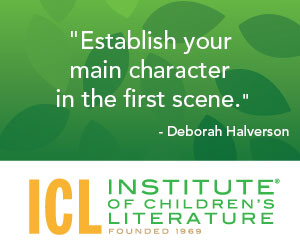1000 N. West Street #1200, Wilmington, DE 19801
© 2024 Direct Learning Systems, Inc. All rights reserved.

We teach our students how to write and get published!
View our Course Catalog >

This is tough for many writers. A book seems to be so many things, all of them interesting, so what do you put in the short book description in your query letter?
Every story is a journey
The first thing to do to help you think of your story in few words is to view it as a journey. Sometimes a story reflects an actual physical journey: an adventure story may be about a kid lost in the woods and how he got out alive. That’s very much a physical journey. Another story may take place when a dad takes his young son on a camping trip, hoping to connect. Again this would have a physical journey to the woods and back again. The physical journey of a story where characters are actively moving from one place to another would obviously let us know about that journey. But what about stories that don’t travel that way? After all, a book could take place entirely in one spot. Then what would be the journey of the story? It would be a journey of character. And it would be a journey of conflict. Even when a character doesn’t move physically from one place to another, he should move emotionally from one place to another. In other words, characters change through the story. (It is a rare story where a character suffers through the buffeting of the plot without changing, and in that kind of story, you’d describe the resistance to the journey, the character’s refusal to change.)
Tell Us Who and Why
Your little synopsis is going to do certain things very quickly. It will show us the main character. It will reveal the primary conflict. It will show the main internal conflict. And it will let us know the book’s goal. Let’s imagine we have written a book about a quirky little girl named Bitty whose mother worries about her daughter’s lack of friends. After a series of her mother’s catastrophic attempts to get Bitty some friends, the girl realizes this is something she’ll have to do if she’s ever to get any peace. So she embarks on a mission to make a friend and settle her mom’s nerves.
So from that you know the main character (Bitty) and her primary conflict (her mother is stressing over the friend thing and making Bitty’s life miserable). We see main character’s goal (make a friend and calm her mother’s fears). So the external journey of the story will be through Bitty’s attempts to make a friend. From what we have so far, we don’t know Bitty’s internal journey. Will she discover friends are pretty great after all? That’s what characters usually learn in this kind of situation, but what if Bitty is different. Maybe she learns something totally different like “sometimes you just have to be the person you are, even when others don’t understand.” Or maybe she learns that her problem wasn’t friendship, it was better communication with her mother. Whatever happens internally for Bitty would have to be part of the synopsis too. We would need to know how the story has changed Bitty. What ultimately does the journey do to her?
But What If You Can’t?
What if you don’t really have just one main character? What if you’re not sure what the primary conflict is? What if the main character doesn’t exactly do anything about the problem? What if all you know really is what the reader should have learned at the end?
The story synopsis part of your query letter or cover letter helps the editor or agent understand the story. But it does something else really well. It shows you where you’ve got a problem. Say you’ve written a short story about three kids who go on a wander through the woods, but none of them is really the main character. In fact, maybe there’s only three of them because you had two brothers when you were a kid or you had three kids of your own or someone told you once about the “rule of three” and you decided to apply that to the number of characters. And suppose those characters mostly learn a lesson about not going off without telling an adult, but beyond that, they just end up stuck in the woods until someone comes along, finds them, and takes them home. In that case, you’ve got a problem, and it’s not the query letter. A story with only vague characters who act in a clump and don’t do anything that leads to the solution of the story is unlikely to make a strong connection with the reader.
That doesn’t mean you can’t have strong side characters. In fact, your main character might even be the slightly quieter character with a bossy best friend. But it does mean that each character needs to be a fully formed person in your head. And each person has goals. And the person with the most compelling goal, that person probably should be your main character.
Questions, It Always Comes Down to Questions
Ask yourself the main questions of any story. Who is the main character? What does that person want or need? What is standing in the way of that? What is the main character going to do about that? And how does this effort/conflict/challenge/struggle change the character? Then when you can answer those questions, you’re halfway to writing a good synopsis. Put those things together into a short, clear road map of the story’s journey.
The other thing to keep in mind is to choose words to reflect the tone (a funny story will have a light, rollicking description while a serious story will sound more serious even in the synopsis) and watch for things that will grab attention. For example, if your story is set in a carnival community, that’s interesting and unusual, so you’d want to be sure to include that. If your story is set during the Molasses flood in Boston, you’ll want to include mention of that, because it’s interesting. But don’t try to force interest in when it doesn’t fit. Don’t paste words like “adventure” on a quiet story about a boy helping his grandfather, just because you know kids like adventures. Instead, work with what is actually in the story.
So find the bones of the story through questions. Write it in a way that shows the journey of the story, both external (what the character does) and internal (how the character changes). And make choices that give us a sense of the kind of story you’re telling, highlighting any especially engaging bits.
It’ll still be challenge, but when done well, it’s a big part of hooking a publisher or agent for your story.
Good luck with it.
With over 100 books in publication, Jan Fields writes both chapter books for children and mystery novels for adults. She’s also known for a variety of experiences teaching writing, from one session SCBWI events to lengthier Highlights Foundation workshops to these blog posts for the Institute of Children’s Literature. As a former ICL instructor, Jan enjoys equipping writers for success in whatever way she can.
1000 N. West Street #1200, Wilmington, DE 19801
© 2024 Direct Learning Systems, Inc. All rights reserved.
1000 N. West Street #1200, Wilmington, DE 19801
© 2024 Direct Learning Systems, Inc. All rights reserved.
1000 N. West Street #1200, Wilmington, DE 19801
© 2024 Direct Learning Systems, Inc. All rights reserved.
1000 N. West Street #1200, Wilmington, DE 19801
© 2025 Direct Learning Systems, Inc. All rights reserved.
1000 N. West Street #1200, Wilmington, DE 19801
©2025 Direct Learning Systems, Inc. All rights reserved. Privacy Policy.